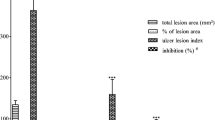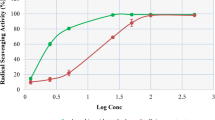Abstract
The present study investigated the gastroprotective effects of a cinnamon diet using different gastric ulcer mouse models. Dose dependency and the effective dose period of administration of a cinnamon powder diet were established using the water immersion stress gastric ulcer model. A cinnamon powder diet significantly protected mice against ulceration by stress, ethanol, HCl and oral administration of aspirin, but not against ulceration by oral administration of indomethacin or subcutaneous administration of indomethacin or aspirin. Such a diet conferred protection against gastric ulcers at an effective concentration of 100 mg cinnamon powder per gram of food after administration for 4 weeks and the active compound of cinnamon powder for gastroprotective activity was identified as cinnamaldehyde. These findings indicate that regular ingestion of cinnamon powder offers gastroprotection presumably through a cytoprotective mechanism but the efficacy against NSAIDs-induced gastric ulcers may be limited.




Similar content being viewed by others
References
Anoop A, Jegadeesan M (2003) Biochemical studies on the anti-ulcerogenic potential of Hemidesmusindicus R.Br. varindicus. J Ethnopharmacol 84:149–156
Singh N, Shukla N, Singh P, Rajendran SM, Maurya R, Palit G (2010) Verbascoside isolated from Tectoniagrandis mediates protection in rats via inhibiting proton pump activity. Fitoterapia 81:755–761
Ibrahim Abdulkarim Al Mofleh (2010) Spices, herbal xenobiotics and the stomach: Friends or foes? World J Gastroenterol 16(22): 2710–2719
Lin CC, Wu SJ, Chang CH, Ng LT (2003) Antioxidant activity of Cinnamomum cassia. Phytotherapy 17:726–730
Akira T, Tanaka S, Tabata M (1986) Pharmacological studies on the antiulcerogenic activity of Chinese cinnamon. Planta Med 52:440–443
Tanaka S, Yoon YH, Fukumi H, Tabata M, Akira T, Okano K, Iwai M, Iga Y, Yokoyama K (1987) Antiulcerogenic compounds isolated from Chinese cinnamon. Planta Med 55:245–248
Kuwayama H, Eastwood GL (1985) Effects of water immersion restraint stress and chronic indomethacin ingestion on gastric antral and fundic epithelial proliferation. Gastroenterology 88:362–365
Robert A, Nezamis EJ, Lancaster C, Hanchar AJ (1979) Cytoprotection by prostaglandins in rats: Prevention of gastric necrosis produced by alcohol, HCl, NaOH, hypertonic NaCl, and thermal injury. Gastroenterology 77:433–443
Suzuki K, Araki H, Mizoguchi H, Furukawa O, Takeuchi K (2001) Prostaglandin E inhibits indomethacin-induced gastric lesions through EP-1 receptors. Digestion 63:92–101
Wang Z, Hasegawa J, Wang X, Matsuda A, Tokuda T, Miura N, Watanabe T (2011) Protective effects of ginger against aspirin-induced gastric ulcers in rats. Yonago Acta Med 54:11–19
Iaquinto G, Giardullo N, Taccone W, Leandro G, Pasquale L, Luca L, Szabo S (2003) Role of endogenous endothelin-1 in ethanol induced gastric mucosal damage in humans. Dig Dis Sci 48:663–669
Amar AR, Maysa ME (2010) Anti-ulcer effects of cinnamon and chamomile Aqueous Extracts in Rat Models. J Am Sci 6(12):209–216
Okada M, Niida H, Takeuchi K, Okab S (1989) Role of prostaglandin deficiency in pathogenetic mechanism of gastric lesions induced by indomethacin. Dig Dis Sci 34(5):694–702
Peskar BM, Maricic N (1998) Role of prostaglandins in gastroprotection. Dig Dis Sci 43:23S–29S
Wallace JL, McKnight W, Reuter BK, Vergnolle N (2000) NSAID-induced gastric damage in rats: requirement for inhibition of both cyclooxygenase 1 and 2. Gastroenterology 119:706–714
Whittle BJ (2003) Gastroprotective effects of nonsteroidal anti-inflammatory drugs. Fundam Clin Pharmacol 17(3):301–313
Wallace JL (2008) Prostaglandins, NSAIDs, and gastric mucosal protection: Why doesn’t the stomach digest itself? Physiol Rev 88:1547–1565
Robert A, Bottcher W, Galanska E, Kauffman GL Jr (1985) Lack of correlation between mucus gel thickness and gastric cytoprotection in rats. Gastroenterology 86:610–674
Hollander D, Tarnawski A, Krause WJ, Gergely H (1985) Protective effect of sucralfate against alcohol-induced gastric mucosal injury in the rat. Gastroenterology 88:374–388
Hudson N, Murray FE, Cole AT (1997) Effect of sucralfate on aspirin induced mucosal injury and impaired haemostasis in humans. Gut 41:19–23
Onodera S, Tanaka M, Aoyama M, Arai Y, Inaba N, Suzuki T, Nishizawa A, Shibata M, Sekine Y (1999) Antiulcer effect of Lafutidine on indomethacin-induced gastric antral ulcers in refed rats. Jpn J Pharmacol 80:229–235
Holzer P (1998) Neural emergency system in the stomach. Gastroenterology 1998(114):823–839
Peskar BM (2001) Neural aspects of prostaglandin involvement in gastric mucosal defense. J Physiol Pharmacol 52(4):555–568
Ai HB, Zhang ZD (1990) Studies on the mechanism of gastric mucosal injury induced by water-immersion stress in rats. Sheng Li Xue Bao 42(5):496–502
Shrikant VJ, Kalyani AK, Urvashi VM, Sandesh RL, Payal DS, Heta GV, Rushi BV, Bhavin AV, Gajanan GK (2001) Alteration of gastric mucus secretion in rats treated with Abelmoschus esculentus seed mucilage. Der Pharmacia Lettre 2011 3(5):183–188
Rujjanawate C, Kanjanapothi D, Amornlerdpison D, Pojanagaroon S (2005) Anti-gastric effect of Kaempferia parviflora. Journal of Ethnopharmacology 102(2005):120–122
Harada M, Yano S (1975) Pharmacological studies on Chinese cinnamon. Effects of cinnamaldehyde on the cardiovascular and digestive systems. Chem Pharm Bull 23:941–947
Shaik MA, Aleem AK, Irshad A, Musaddiq M, Khaja SA, Polasa H, Venkateswar RL, Chittoor MH, Leonardo AS, Niyaz A (2005) Antimicrobial activities of Eugenol and Cinnamaldehyde against the human gastric pathogen Helicobacter pylori. Ann Clin Microbiol Antimicrob 4:20
Capasso PL, Vuotto ML, Di Carlo G (2000) Preventive effect of eugenol on PAF and ethanol-induced gastric mucosal damage. Fitoterapia 71:131–137
Acknowledgments
This work was funded by Takeda Science Foundation (2009 grant), Kyoto, Japan.
Author information
Authors and Affiliations
Corresponding author
Electronic supplementary material
Below is the link to the electronic supplementary material.
11418_2012_680_MOESM1_ESM.tif
Supplementary Figure 1. Pictomicrograph showing thickened mouse gastric mucosa after completion of the 4-week cinnamon powder diet. A, Cinnamon-treated group. B, Control group. Scale bar, 100 μm. (TIFF 1202 kb)
11418_2012_680_MOESM2_ESM.tif
Supplementary Figure 2. Chemical fingerprints of EACC (A), fraction 1 (B), fraction 2 (C) and fraction 3 (D). Peaks 1, unidentified; 2, cinnamylalcohol; 3, coumarin; 4, cinnamaldehyde; 5, eugenol; 6, cinnamyl acetate; 7, unidentified. HPLC conditions: Column pack: ODS/R: 10 μl, 120 A, 4.6 × 250 mm. I.D. Program: 37 % MeOH (at 0 min) – 100 % MeOH (at 30 min). Flow Rate: 1 ml/min. Injection volume: 3 μl. Detection: UV 254 nm. (TIFF 671 kb)
Rights and permissions
About this article
Cite this article
Tankam, J.M., Sawada, Y. & Ito, M. Regular ingestion of cinnamomi cortex pulveratus offers gastroprotective activity in mice. J Nat Med 67, 289–295 (2013). https://doi.org/10.1007/s11418-012-0680-9
Received:
Accepted:
Published:
Issue Date:
DOI: https://doi.org/10.1007/s11418-012-0680-9




